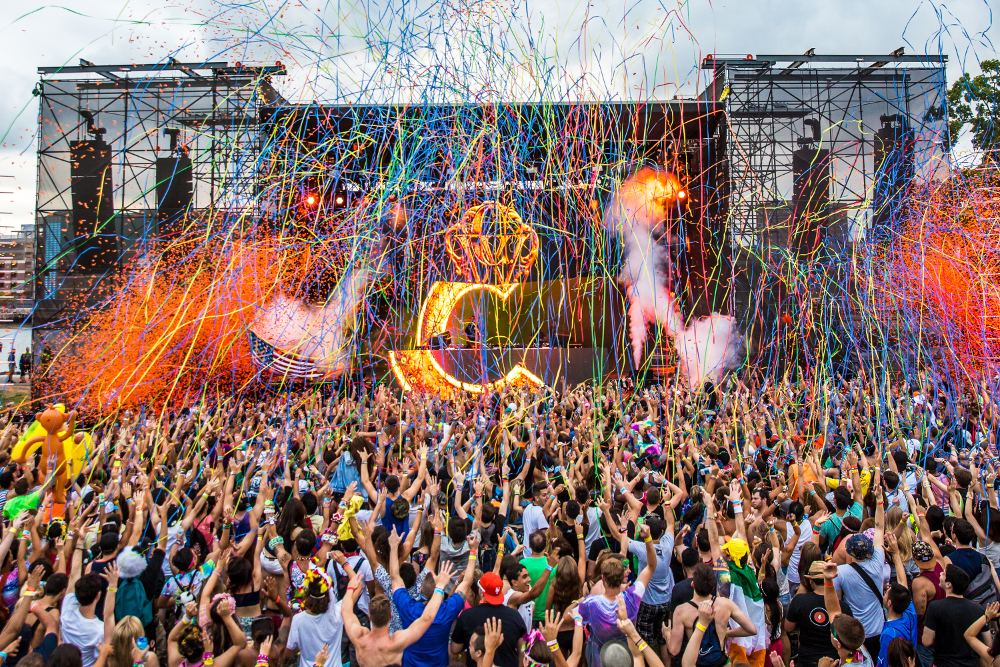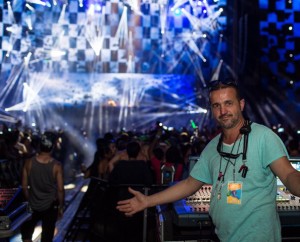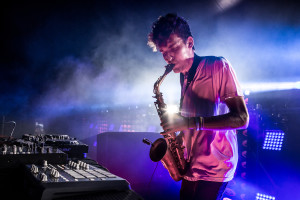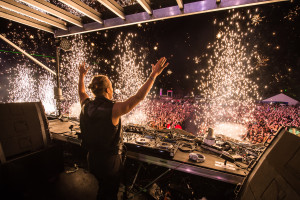Electric Zoo Transformed: Inside the Live Sound for NYC’s Signature EDM Festival
Now at seven years and counting, the home of one of the world’s premier EDM festivals is the global music capital of New York City – right where it should be.
In 2015, the famed event is going by the moniker Electric Zoo: Transformed, taking place on September 4-6 over Labor Day weekend at Randall’s Island Park. While transformation and evolution will no doubt be on display, one thing that remains consistent from years past is excellent live sound.
That’s because the audio consultant overseeing Electric Zoo’s powerful sound systems isn’t just a hired gun – he’s George Stavro, one of the festival’s founding partners. His NYC-based companies, Sonic Lab Audio and Integral Sound, were on the ground floor for the creation of Electric Zoo, which means he’s 100% vested in delivering spectacular sound to the thousands of electronic music fans who annually flock to the Zoo.
This year, Stavro and his crew will oversee four stages featuring global superstars including The Chemical Brothers, Zeds Dead, Borgore, 3LAU, Above & Beyond, Adventure Club, NERVO, Dirty South, Alesso, Deorro, DVBBS, Oliver Heldens, Ummet Ozcan, The Glitch Mob and dozens more.
How does Stavro make it happen? See how this gatekeeper of elite audio maintains command.

Electric Zoo 2014 built on the live sound expertise of NYC’s premier EDM festival. (Photo Credit: aLive Coverage)
What’s the first thing you do to get the live sound set up for Electric Zoo?
We look at the site layout, and then try to make a rough system layout that stops crosstalk and noise bleed between stages. You don’t want to be hearing three stages at the same time – Randall’s Island is an extremely small site, so it has been quite a task.
Before we design the sound system, we find where the stage will be positioned, and in which direction it will be facing. That changes from year to year as the festival grows. Something that worked for previous years aesthetically might not work this year, or perhaps the traffic flow could be better. Authorities might want a certain amount of egress. There’s a rhyme and reason, and I’m not privy to all of it.
Once that’s done, then you look at the production design: If the designers want to have a stage that’s 200 feet wide, and we want the sound to accommodate that. So we look at the size of the structure, the size of the stages, and then design the sound system around that.
You’ve been putting on Electric Zoo every Labor Day weekend since 2009. What does each year teach you from an audio standpoint?
I think it’s more a refinement. The first couple of years we figured out how to do stuff, and how to cover multiple stages on such a small site. Especially with the main stage – it’s inevitable that when the headliners are on, you have half of the festivalgoers at the main stage, so you have to throw longer.
To deal with that, we create delay zones that we can turn on and off at will. It becomes about how you manage the sound throughout the day. You can’t cheat physics, you can only defy it up to a point! It’s there that you deal with it, then it becomes about noise management.
Once you’ve completed the site survey and the stage designs are in, what comes next?
Then it’s about designing a sound system that would work. The brief to our partner audio company is that we want the best sound possible, with budget not being a consideration. The cost can’t be ridiculous, of course, but the brief has always been to get the best possible sound first, then deal with the cost.
How does the fact that the system is going to be for EDM make it different then it would be for a rock festival, for example?
We are primarily a dance music audio vendor. We’ve always done clubs, and we’re responsible for some of the most famous nightclubs in the world. Our specialty has always been nightclub sound, and that’s what we do. So when we design a system, we generally do it that way. Not that we haven’t done rock shows — we have — but our primary focus has been sound for electronic music. What we’re really trying to do is give everyone an immersive experience with the sound as you would in a club, but on a much grander scale.
The design philosophy is to have a sonic signature across the whole site. What we try and do is have the same type of speakers at each stage, so the tonal response is alike. For example if you’re playing Madonna’s “Holiday” on one stage, when you hear it on another stage later it will sound identical.
The objective is uniformity on all setages – not one system that’s bass-heavy and another that’s midrange-heavy. That’s important because you want to try and give everyone the same experience. You don’t want to have a “bastard child” stage, so we try to have the best possible sound across each stage.
The systems are different sizes, but generally the components are the same. It’s just a different configuration of it, all with the sonic characteristics of a good balanced system.
When it comes to EDM, how should a well-balanced system perform?
We want the subs to provide a tactile experience, to give the bass a sense of physicality. Unlike a rock show that goes 90 minutes, these electronic shows go 9 or 10 hours — the exposure’s a lot longer. You don’t want the sound to be aggressive or hard, you want it to be smoother while still creating a physical presence.
I’d tell you how we do that, but then I’d have to kill you! (Laughs) We’re renowned for our systems to not be fatiguing, and for people to leave without their ears ringing.
What speakers do you employ at Electric Zoo?
Most of the systems will be based on D&B Audiotechnik speakers – mostly J12, J-SUBs, and B2-SUBs.
The main stage line array will probably be 16 deep. We’ll hang 8 to 10 of the J-SUBs, and then we use around 30 of the B2-SUBs in cardioid sub array stacks, which is one facing backwards and two facing forward – that’s called a CSA stack. This creates a cancellation wave in back, so there’s more energy in the front with cancellation in the rear.
How about monitors?
When it comes to DJ monitors, there’s a big trend towards small line array boxes for monitor applications. We don’t agree with that, because line array speakers are very directional, especially in the mid and high range, and when you listen closely you don’t get the efficiencies.
We prefer a full-range box for better near field listening, so we use a D&B C7 on top of a J-SUB. Or, depending on the sight lines, we use multiple D&B M2 monitors with J-SUBs.
What are your goals when it comes to flexibility and versatility of the system?
The Electric Zoo sound system has to meet certain performance requirements and specs. EDM is primarily bass-driven, but some of it is more melodic, some more vocally-driven – so each of them produce the entire spectrum of sound.
We design for our performance specification foremost in mind, and in general that’s good enough to do any genre of dance music, and really any genre of anything.
Is there one Front of House (FOH) mixer for everybody, or does each artist have their own mix engineer?
There’s one designated, but that’s something we choose at the last minute. Some of the artists have an engineer, some don’t. Some have a preference on consoles, others don’t. We use either a DiGiCo, Yamaha or a Midas PRO digital mixer – that’s generally what we specify.
What does the console need to be capable of for the Electric Zoo Festival?
Very little, actually! You don’t mix a DJ, you just attenuate. We generally use a console for splitting mixes, using a Lab.gruppen Lake Processor to do that.
We’re generally looking at quality more than anything else, and we need the console to feed our digital processing and the rest of the system. We’re not looking for digital effects or even multiple channels — the max that we’ve seen is six inputs for three different DJs.
A live artist like the Chemical Brothers may have a different spec, they may have other equipment that require multiple channels, but generally the DJ is going to send you a stereo output. And as I said, you don’t mix a stereo output, you just attenuate it.
What’s going on at the monitor mix position?
Again, the monitors are basically a direct feed off the DJ. The reason we have a monitor console in place is in case the artist has a vocalist or other musicians that require more monitor mixes.
Generally, it’s a direct path from the DJ mixer booth output straight back to their monitors. We like to keep that path as short as possible, because anything more intensive will create some sort of latency. Once it goes out of the outputs, back to the console, through the speakers, etc… you’re creating some sort of delay, so we try to keep that to a minimum.
After you’ve got the system all set up, what happens next?
Once the festival starts and we have the sound we want, we’re just watching and fine tuning. We try and maintain a particular sound, so it’s optimization then, tweaking for changes in weather conditions like humidity, and then managing levels throughout the whole site.
It’s show mode, as opposed to build mode. Everyone’s on standby in case there’s technical issues. Last year there was a major storm, so we had to power everything down and make sure that it was covered.
The stage is usually started a good two weeks before. I go in on the Monday before the event, which gives me four days or so. I get in there early, checking on the PA wings, making sure they’re the right height and the right appearance.
Electric Zoo is definitely one of the festivals that’s broken through. Why do you think it continues to grow?
It’s really the only dance music festival in New York City which is the spiritual home of clubbing.
Personally, I’ve been involved with the festival since before its inception, so I’m emotionally attached to it. And it’s on home turf: Electric Zoo is an NYC-based operation.
Having a long relationship with the founders, you feel personally involved. I’ve been working with some of the people who are involved for over 20 years, so it has a sense of familiarity and family to it. We’ve worked together in clubs, started off as interns, and now are pretty much running the show, so you have a shared history that goes beyond a paid gig. We’ve known each other since we had hair and slim waist lines! (Laughs)
Some people looking at the success of Electric Zoo are bound to be inspired. Is there room in the world for another festival – is this something that a musical entrepreneur that’s reading this should attempt to do?
Holy hell…I’d say go for it if you know what you’re doing! Personally, I think there’s a bit of saturation in the festival market, but there’ll always be room for a good product.
If you’re going to do it, do something that 10 people aren’t already doing. Some of the best festivals now are the smaller, more quirky things. Have creative music people drive the process and direct the process. I also do a festival in Mexico called BPM, which isn’t site-related, it’s venue-specific: They’ll have nine or 10 different venues, it’s a totally different concept, and very fun as well.
I’d recommend that if someone wants to start a live music festival, go ahead and do something! Just do something that’s uniquely yours.
— David Weiss
Please note: When you buy products through links on this page, we may earn an affiliate commission.










Aristedes P DuVal
September 3, 2015 at 1:27 pm (9 years ago)EDM is mostly Garbage CLAPTRAP disguised as”Music” which can sound good under the influence of many BIZARRE EXPERIMENTAL drugs that are being TESTED on the stoopid participants.